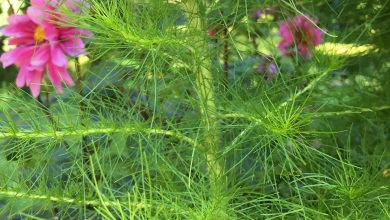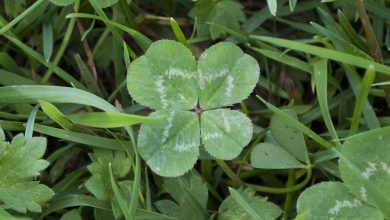Elephant Garlic: [Characteristics, Care, Planting and Reproduction]

Important points when sowing Elephant Garlic:
- When? Early fall.
- Where? Outdoors, in a wide field because they will take up space.
- How do we prepare the land? Stirring a little before sowing so that the soil is aerated. Preferably, slightly acidic soils with good drainage capacity.
- How should we water? By drip, taking good care of the amount of water to avoid puddles.
- How often do you have to water? Few irrigations during the cultivation phase and suspend them before harvest. If it rains, don’t water.
- What care do you need? Mild temperatures throughout the year, strip crops of weeds, keep the distance between plants.
- What pests and diseases does it have? It does not have major problems with attacks, unless they are caused by excess watering. The most that has come to cause problems and in a minimal amount is rust.
 Elephant garlic is a giant version of the garlic that we know popularly, and can be up to 3 times the size of normal garlic.
Elephant garlic is a giant version of the garlic that we know popularly, and can be up to 3 times the size of normal garlic.
The taste is also different, since in this case it is something more delicate to the palate. This makes it easy for it to be consumed both in hot preparations and in salads.
What do you need to enjoy elephant garlic at home? It is what we are going to deal with today so do not miss a single line.
What is elephant garlic?
Elephant garlic is a “giant” sized bulb whose diameter can reach up to 10 centimeters.The plant on the surface develops wide and long leaves that look strong and very defined.
It is a species that is more inclined towards the characteristics of the leek than towards garlic as such, but due to its structure it was given this name.
Despite its size, the number of teeth is not very numerous, since they are usually only 4 to 6. It comes from Chile, but thanks to the adaptation processes it is now possible to have it in European home gardens.
What kind of plant is elephant garlic?
 Garlic is a plant that produces a very popular bulb in the kitchen of almost everyone.
Garlic is a plant that produces a very popular bulb in the kitchen of almost everyone.
It belongs to the Liliaceae family and is made up of a structure with teeth, skins and propagules.
The teeth are a reduced number of maximum 6 for each head. Sometimes, they can be even less, 3 or 4. The important thing is that they are very big.
In the case of the skins, the first is delicate, soft and white, while that of the teeth tends to be thicker and yellowish. The propagules have the germinative function of the plant, although they do not do so quickly, since the flowers hardly generate seeds.
How to take care of elephant garlic?
Elephant garlic prefers specific conditions that will help it develop better. These include:
- A mild temperature, both for the cold winter and for the warmth of summer. The temperate climate is ideal, especially the one that is oriented towards the coasts.
- It does not need very frequent watering because it is especially delicate in the presence of waterlogging.
- It is necessary to be attentive to the presence of weeds around the crops that can cause a competition for nutrients and water with the garlic.
- Maintain the appropriate distance between one plant and another considering the size that the bulbs will reach underground.
When is elephant garlic planted?
This is a garlic that needs a long period of work to harvest, around 240 days. In places where there are usually no frosts, where the soil does not freeze in winter, sowing is established in the autumn period.
How is elephant garlic planted?
 Elephant garlic can be grown from two sources: the cloves and the seeds.
Elephant garlic can be grown from two sources: the cloves and the seeds.
The cloves are the ones that offer the best results and it is achieved by planting one with the widest part downwards. These teeth will be buried in a universal substrate and placed in full sun.
In the case of seeds, you will have to work them in nurseries to wait for one to offer correct germination.
The idea is that you fill the seedbeds with substrate and water it until you notice that the entire extension is well moistened. Then, place two seeds for each of the seedbeds, covering them with a light layer of substrate.
Water with a low-flow water source, such as a spray bottle, to impregnate that light layer you’ve established. It is necessary that this seedbed enjoy the environmental conditions of the exterior, but keeping it in semi-shade.
If all goes well, the seeds should start to show their first movements in about 15 days. Take into account that you should check the seedbeds daily to provide the necessary humidity and prevent the substrate from drying out.
How does elephant garlic reproduce?
 Elephant garlic produces a flower at the end of its lifespan that sometimes leads to seeds.
Elephant garlic produces a flower at the end of its lifespan that sometimes leads to seeds.
These seeds are very little usable for the reproduction of plants.
So the most effective method is through the cloves, as with normal garlic. In the case of propagules, the work system is even less positive, so it is not highly recommended.
How do you prune the elephant garlic plant?
 Garlic plants are not pruned. What is evidenced as drying of the leaves in the superficial part is only indicative that they are ready to harvest.
Garlic plants are not pruned. What is evidenced as drying of the leaves in the superficial part is only indicative that they are ready to harvest.
Therefore, this care that is so essential in other species can be crossed off your list of requirements for elephant garlic.
Other names by which this species is known are oriental garlic, large-headed garlic or chilote garlic. Although it is a very striking species to use in the kitchen, it is not often seen for sale at a commercial level.
That means that the power of having them in your hands responds to your deciding to plant them, if you want, right now.
Bibliographic references
- Contribution to knowledge for the production of elephant garlic (Allium ampeloprasum complex), in Mendoza, Argentina, S Lanzavechia – Horticultura Argentina, 2009 – horticulturaar.com.ar
- Elephant garlic drying, L Vignoni, V Araniti, P Winter… – Magazine of the…, 2002 – planificacion.bdigital.uncu.edu.ar
- Etiological study of anomalies in elephant garlic bulbs (Allium ampeloprasum var. holmense), from the Quillota and Nogales area, A Vejar, F Rodrigo – 1997 – sidalc.net
- Physiological and agronomic characterization of “ Elephant Garlic ”(), in San Carlos, Mendoza, Argentina, S Lanzavechia – inta.gob.ar
- MAIN PHYTOPATHOGENIC FUNGI ASSOCIATED WITH STORED ELEPHANT GARLIC BULBS (Allium ampeloprasum var. holmense) FROM THE QUILLOTA AND NOGALES AREA (CHILE), XA Besoain, A Rodrigo Véjar, E Piontelli – Mycological Bulletin, 2002 – micologia.uv.cl
Maybe you are also interested in:


![Photo of The Aralia: [Characteristics, Planting, Care, Irrigation and Substrate]](https://www.complete-gardening.com/wp-content/uploads/2022/08/the-aralia-characteristics-planting-care-irrigation-and-substrate-390x220.jpg)
![Photo of Lantana: [Cultivation, Care, Irrigation, Substrate, Pests and Diseases]](https://www.complete-gardening.com/wp-content/uploads/2022/08/lantana-cultivation-care-irrigation-substrate-pests-and-diseases-390x220.jpg)
